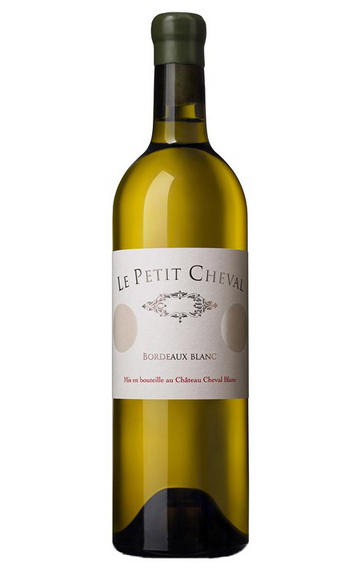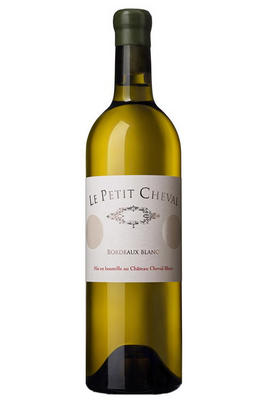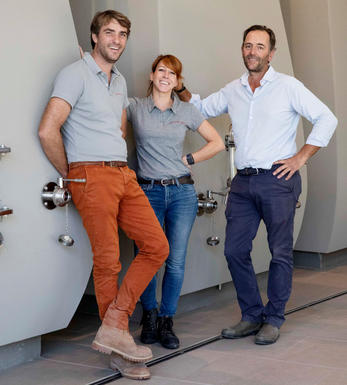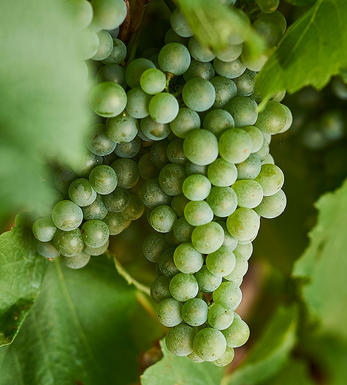
2020 Le Petit Cheval Blanc, Bordeaux

Critics reviews
The 2020 Le Petit Cheval (Blanc) is fabulous. Rich, creamy and wonderfully expansive, the 2020 is just gorgeous. Lemon confit, white flowers, passion fruit and a touch of oak all grace this wonderfully expressive dry white from Cheval Blanc. I especially like how the 2020 gains freshness with aeration, which is always a good sign with whites. There's tremendous precision and class here.
Drink 2025 - 2038
Antonio Galloni, Vinous.com (February 2023)
Le Petit Cheval Blanc 2020 soars from the glass with notions of white peaches, green guava, and passion fruit, giving way to hints of orange blossom, beeswax, elderflower, and cedar. The medium-bodied palate is refreshing and elegantly weighted, with intense tropical flavors and a long zippy finish.
Lisa Perrotti-Brown MW, The Wine Independent
Sémillon was added to the blend of the Cheval Blanc white from 2018, and it was immediately apparent that it added an extra layer of interest. This is a vintage that I've tried several times over the past few years, and it keeps getting better, showing white peaches riven with waxy lemon rind, sage and saffran that bring it in line with the complexity and finesse of the rest of the (red) Cheval stable. Aged for 18 months in large-sized new oak barrels.
Drink 2023 - 2032
Jane Anson, JaneAnson.com (June 2023)
Lovely, lovely wax and cooked lemon fruit aromas. Excellent sweet-spice and white-chocolate complexity. Very expressive. Relatively soft but still has the crispness and precision of Sauvignon Blanc. Long, mulchy sort of length.
Drink 2022 - 2026
Richard Hemming MW, JancisRobinson.com (February 2023)
80% Sauvignon Blanc and 20% Semillon.
Rather tropical fruit aromas like pineapple, mangoes, white peaches, and lemons with hints of stones and minerals. It’s full-bodied with plenty of fruit, yet it’s fresh and steely. Lots of white peaches at the end. Hints of lees, too, like bread dough.
James Suckling, JamesSuckling.com (May 2023)
About this WINE

Château Cheval Blanc
Château Cheval Blanc, a 1er Grand Cru Classé (A) is unquestionably the leading estate in St. Emilion. It is located in the north-west of the St. Emilion appellation, bordering Pomerol.
Cheval Blanc's vineyards (Merlot 39%, Cabernet Franc 57%, Malbec 3%, Cabernet Sauvignon 1%) enjoy a variety of soils: gravel, clay and sand, all underpinned by an impermeable sedimentary rock (`crasse de fer'). Fermentation and maceration last 4 weeks in stainless steel vats, followed by 18 months' maturation in new oak barrels.
Cheval Blanc produces the most famous Cabernet Franc-based wine in the world and present régisseur Pierre Lurton is amongst the most talented winemakers working in Bordeaux today. Cheval Blanc requires a minimum 10 years of bottle age and the best vintages can last for 50 years or more.

St Émilion
St Émilion is one of Bordeaux's largest producing appellations, producing more wine than Listrac, Moulis, St Estèphe, Pauillac, St Julien and Margaux put together. St Emilion has been producing wine for longer than the Médoc but its lack of accessibility to Bordeaux's port and market-restricted exports to mainland Europe meant the region initially did not enjoy the commercial success that funded the great châteaux of the Left Bank.
St Émilion itself is the prettiest of Bordeaux's wine towns, perched on top of the steep limestone slopes upon which many of the region's finest vineyards are situated. However, more than half of the appellation's vineyards lie on the plain between the town and the Dordogne River on sandy, alluvial soils with a sprinkling of gravel.
Further diversity is added by a small, complex gravel bed to the north-east of the region on the border with Pomerol. Atypically for St Émilion, this allows Cabernet Franc and, to a lesser extent, Cabernet Sauvignon to prosper and defines the personality of the great wines such as Ch. Cheval Blanc.
In the early 1990s there was an explosion of experimentation and evolution, leading to the rise of the garagistes, producers of deeply-concentrated wines made in very small quantities and offered at high prices. The appellation is also surrounded by four satellite appellations, Montagne, Lussac, Puisseguin and St. Georges, which enjoy a family similarity but not the complexity of the best wines.
St Émilion was first officially classified in 1954, and is the most meritocratic classification system in Bordeaux, as it is regularly amended. The most recent revision of the classification was in 2012

Sauvignon Blanc & Sémillon
The blend used for White Graves and Sauternes and rarely encountered outside France. In the great dry whites of Graves, Sauvignon Blanc tends to predominate in the blend, although properties such as Smith Haut Lafite use 100% Sauvignon Blanc while others such as Laville Haut Brion have as much as 60% Sémillon in their final blends. Sauvignon Blanc wines can lose their freshness and fruit after a couple of years in bottle - if blended with Sémillon, then the latter bolsters the wine when the initial fruit from the Sauvignon fades. Ultimately Sauvignon Blanc gives the wine its aroma and raciness while Sémillon gives it backbone and longevity.
In Sauternes, Sémillon is dominant, with Sauvignon Blanc playing a supporting role - it is generally harvested about 10 days before Sémillon and the botrytis concentrates its sweetness and dampens Sauvignon Blanc`s naturally pungent aroma. It contributes acidity, zip and freshness to Sauternes and is an important component of the blend.


Buying options
Add to wishlist
Description
Sémillon was added to the blend of the Cheval Blanc white from 2018, and it was immediately apparent that it added an extra layer of interest. This is a vintage that I've tried several times over the past few years, and it keeps getting better, showing white peaches riven with waxy lemon rind, sage and saffran that bring it in line with the complexity and finesse of the rest of the (red) Cheval stable. Aged for 18 months in large-sized new oak barrels.
Drink 2023 - 2032
Jane Anson, JaneAnson.com (June 2023)
wine at a glance
Delivery and quality guarantee